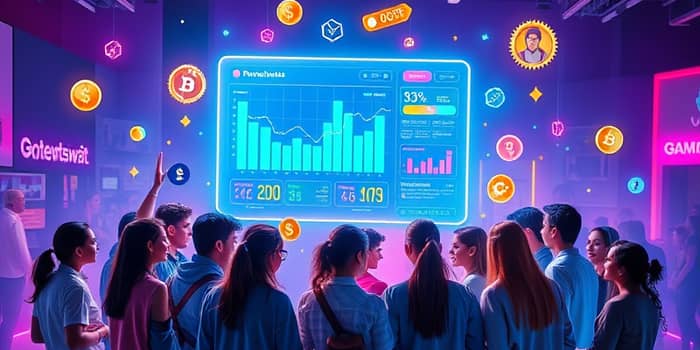In a world saturated with digital distractions, the realm of personal finance has found a surprising ally in the language of play. Gamification—the process of applying game-design elements to non-game contexts—has transcended mere novelty to become a strategic imperative for banks, fintech startups, and investment platforms. By weaving competition, rewards, and storytelling into financial tasks, these companies are crafting immersive experiences that resonate deeply with today’s users.
Gone are the days when checking an account balance felt like reviewing a chore list. Modern financial apps now invite users to embark on quests, earn badges, and climb leaderboards. This shift is not accidental; it reflects a broader cultural movement toward interactive, visually rich interfaces that speak to younger, digitally savvy audiences. As a result, gamification is redefining how individuals approach money, turning every deposit or budget review into an opportunity for growth and engagement.
The Rise of Gamification in Finance
Over the past decade, the fintech landscape has rapidly evolved. Traditional brick-and-mortar banks are challenged by nimble startups that prioritize user experience above all else. Integrating game elements emerged as a natural progression: if people love using apps that reward them for small wins, why not apply the same principles to money management?
Platforms like Monzo and Moneybox pioneered this approach, adding progress bars and automated challenges to everyday transactions. Monzo’s “1p Saving Challenge” encourages users to save incrementally, with the promise of a £10,000 prize at year’s end. Meanwhile, Moneybox’s round-up feature funnels spare change into investments, eliminating the intimidation factor for novice investors. These innovations signal a paradigm shift: finance is no longer passive, but a dynamic journey marked by continuous micro-achievements.
This trend gained further momentum during the global pandemic, when digital engagement soared and consumers sought new ways to connect with financial services remotely. In markets like India, Google Pay’s 2020 “Go India” campaign used digital scratch cards and collectible tokens to spark enthusiasm among millions. Such success stories underscore how well-crafted gamification can drive massive platform adoption and foster brand loyalty.
Why Gamification Works — Psychology and Engagement
Gamification’s effectiveness lies in its alignment with human psychology. Earning points, unlocking levels, or receiving instant feedback triggers the brain’s reward circuitry, releasing dopamine and reinforcing positive behaviors. Over time, these small victories build momentum, leading users to repeat and internalize financial habits.
Moreover, visual elements like streak counters and progress bars offer clear, intuitive feedback on performance. When users see their investment grow or their savings target inch closer, they experience celebrate milestones with rewarding visual feedback. This tangible representation of effort and reward is crucial in sustaining motivation, especially when dealing with abstract concepts like compound interest or long-term budgeting.
Social features add another layer of engagement. Leaderboards and community challenges tap into our innate desire for recognition and belonging. Sharing achievements with friends or climbing a public ranking can inspire friendly competition, driving users to push further. By fostering habit formation through positive reinforcement, gamification not only attracts users but also fosters enduring loyalty.
Case Studies: Real-World Success Stories
To appreciate gamification’s impact, consider how leading platforms have leveraged these mechanics to achieve both user satisfaction and business growth. From UK challenger banks to global payment giants, the evidence is compelling.
These case studies reveal a common theme: blending finance with playful design can dramatically increase both adoption and retention. Fintech leaders are discovering that by offering a sense of continuous progress, they transform abstract financial goals into engaging, achievable adventures.
Common Game Mechanics in Financial Products
Successful gamification strategies rely on a toolbox of mechanics designed to motivate, educate, and retain users. Among the most impactful are:
- Progress bars and visual trackers that illustrate savings and investment milestones
- Leaderboards to inspire friendly competition and community bonding
- Achievement badges and virtual coins redeemable for exclusive rewards
- Timed challenges and streak bonuses that maintain user focus and drive consistency
- Risk-free simulation environments for practice and skill development
When combined thoughtfully, these elements create an environment where users are consistently nudged toward positive financial behaviors. Whether completing a weekly challenge or unlocking a new badge tier, each interaction reinforces progress and strengthens long-term commitment.
Challenges and Critiques
Despite its benefits, gamification in finance is not without pitfalls. Critics warn against oversimplifying complex financial decisions, cautioning that too much emphasis on play could trivialize real-world risks. Maintaining balanced blend of fun and seriousness is essential to ensure users make informed choices rather than pursuing rewards at any cost.
Transparency is another critical concern. Some platforms may obscure fees or profit from user deposits, leveraging game mechanics to distract from underlying costs. Ensuring full disclosure of charges, investment strategies, and data practices is paramount in building and preserving trust.
Finally, the novelty of gamified features can fade. If platforms fail to update incentives or introduce fresh challenges, engagement can wane. Continuous innovation—through user feedback loops, seasonal campaigns, and evolving reward structures—is necessary to keep the experience vibrant and meaningful.
The Future: Educating and Empowering Next-Gen Investors
Looking forward, the fusion of gaming and finance is poised to deepen. Emerging technologies like augmented reality (AR) and AI-driven personalization will create immersive, tailored experiences. Imagine an AR overlay that visualizes your financial journey in real time or AI-powered coaches that adapt challenges to your unique goals.
At the same time, social learning will take center stage. Community quests, peer-to-peer mentorship, and collaborative goal-setting can harness collective wisdom to drive success. By fostering empowering younger, digital-native users through shared experiences, platforms can cultivate a culture of financial responsibility and mutual support.
The ultimate promise of gamification is not just increased engagement, but genuine empowerment. By lowering the barrier to financial education and translating abstract concepts into actionable, rewarding steps, fintech innovators can equip millions to build healthier money habits. As these technologies mature, we will witness a new era where mastering personal finance feels less like a chore and more like an exhilarating game—one with life-changing rewards.
In the grand narrative of financial evolution, gamification stands out as a beacon of possibility. It reminds us that learning can be joyful, that progress can be celebrated, and that any individual—regardless of age or background—can become an astute, engaged investor. The playground of finance is expanding, and the next generation of users is ready to play.
References
- https://www.miquido.com/blog/gamification-in-financial-services/
- https://www.goldenflitch.com/blog/gamification-in-banking
- https://www.finextra.com/blogposting/25083/10-best-practice-examples-of-gamification-in-financial-services
- https://playable.com/blog/gamification-in-finance/
- https://www.truist.com/money-mindset/principles/mind-money-connection/how-to-gamify-finances
- https://yukaichou.com/gamification-examples/top-10-finance-apps-for-2017-from-an-octalysis-gamification-perspective/
- https://www.purrweb.com/blog/gamification-in-banking-features-benefits-costs/
- https://strivecloud.io/blog/fintech-gamification-examples/










